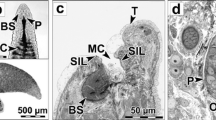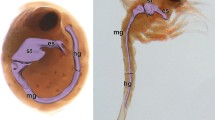Abstract
The intestinal epithelium of third-stage larvae and adults of Cystidicoloides ephemeridarum from haemocoel of mayflies and stomach of brown trout was studied by electron microscopy and cytochemistry. In section, the intestine of both stages is composed of a single layer of about ten undifferentiated intestinal cells in a ring. A labyrinth of deep invaginations is present in the basal region of each cell. The apical surface is modified into well developed, regularly arranged microvilli. These, together with numerous organelles engaged in metabolism and a well defined gut lumen filled with unidentifiable material suggest that the intestine may function in digestion and absorption during both stages. The adults seem to feed upon the semifluid content of the stomach of brown trout. Fortuitous oral infection with undetermined bacteria in vitro led to degenerative changes in the intestinal tissue and probably caused death of the infected specimens. Up to 75% of the cell volume in the L3 is occupied by glycogen deposits. In the adults, a minor portion of glycogen, together with lipid droplets, has been observed. The adults are considered to rely more on aerobic metabolism, whereas anaerobic metabolism (glycolysis) may prevail in L3.




Similar content being viewed by others
References
Behm CA (2002) Metabolism. In: Lee DL (ed) The biology of nematodes. Taylor & Francis, London
Bird AF, Bird J (1991) The structure of nematodes. Academic, London
Chen CC, Chen CS (1995) Brugia pahangi: effects of melanization on the uptake of nutrients by microfilariae in vitro. Exp Parasitol 81:72–78
Chen SH, Howells RE (1979) The uptake in vitro of dyes, monosaccharides and amino acids by the filarial worm Brugia pahangi. Parasitology 78:343–354
Chitwood BG, Chitwood MB (1950) An introduction to nematology. Chitwood, Baltimore
Colam JB (1971) Studies on gut ultrastructure and digestive physiology in Cosmocerca ornata (Nematoda: Ascaridida). Parasitology 62:259–272
Fawcett DW (1966) An atlas of fine structure. Saunders, Philadelphia
Frantová D, Moravec F (2003) Ultrastructure of the body wall of Cystidicoloides ephemeridarum (Nematoda, Cystidicolidae) in relation to the histopathology of this nematode in salmonids. Parasitol Res 91:100–108
Frantová D, Moravec F (2004) Ultrastructure of the body wall of infective larvae of Cystidicoloides ephemeridarum (Nematoda, Cystidicolidae) from mayflies. Parasitol Res (in press)
Franz M, Andrews P (1986) Fine structure of adult Litosomoides carinii (Nematoda: Filarioidea). Z Parasitenkd 72:537–547
Franz M, Büttner DW (1983) The fine structure of adult Onchocerca volvulus V. The digestive tract and the reproductive system of the female worm. Tropenmed Parasitol 34:155–161
Franz M, Melles J, Büttner DW (1984) Electron microscope study of the body wall and the gut of adult Loa loa. Z Parasitenkd 70:525–536
Hodgkin J, Kuwabara PE, Corneliussen B (2000) A novel bacterial pathogen, Microbacterium nematophilum, induces morphological change in the nematode C. elegans. Current Biol 10:1615–1618
Howells R E, Blainey J (1983) The moulting process and the phenomenon of intermoult growth in the filarial nematode Brugia pahangi. Parasitology 87:493–505
Komuniecki R, Harris BG (1995) Carbohydrate and energy metabolism in helminths. In: Marr JJ, Muller M (eds) Biochemistry and molecular biology of parasites. Academic, London
Lamah T, Franz M, Mehlhorn H, Taraschewski H (1990) Comparison of Philometra ovata Zeder, 1803 and Anguillicola crassus Kuwahara et al., 1974 (Nematoda, Dracunculoidea)—a light and electron-microscopic studies. Ann Sci Nat Zoo Biol Anim 11:123–133
Laurence BR, Simpson MG (1974) The ultrastructure of the microfilariae of Brugia, Nematoda: Filarioidea. Int J Parasitol 4:523–536
Lee CC, Miller JH (1969) Fine structure of the intestinal epithelium of Dirofilaria immitis and changes occurring after vermicidal treatment with caparsolate sodium. J Parasitol 55:1035–1045
Lee DL, Atkinson HJ (1976) Physiology of nematodes, 2nd edn. Macmillan, London
Lincoln RC, Anderson RC (1973) The relationship of Physaloptera maxillaris (Nematoda: Physalopteroidea) to skunk (Mephitis mephistis). Can J Zool 51:437–441
Moravec F (1994) Parasitic nematodes of freshwater fishes of Europe. Kluwer, Dordrecht
Moravec F, Frantová D (2003) Observations on the transmission and the seasonality of infection of the nematode Cystidicoloides ephemeridarum in Salmo trutta fario in a small trout stream in North Bohemia, the Czech Republic. Acta Parasitol 48:41–46
Munn EA, Greenwood CA (1983) Endotube brush-border complexes dissected from the intestines of Haemonchus contortus and Ancylostoma caninum. Parasitology 87:129–137
Munn EA, Munn PD (2002) Feeding and digestion. In: Lee DL (ed) The biology of nematodes. Taylor & Francis, London
Ogbogu VC, Storey DM (1996) Ultrastructure of the alimentary tract of third-stage larvae of Litosomoides carinii. J Helminthol 70:223–229
Riley J (1973) Histochemical and ultrastructural observation in Tetrameres fissispina Diesing, 1861 (Nematoda: Spiruroidea) with a special reference to intracellular digestion. Int J Parasitol 3:157–164
Simpson CF, Carlisle JW, Conti JA (1984) Tetrameres columbicola (Nematoda: Spiruridae) infection of pigeons: ultrastructure of the gravid female in glands of the proventriculus. Am J Vet Res 45:1184–1192
Thiéry J-P (1967) Mise en évidence des polysaccharides sur coupes fines en microscopie électronique. J Microsc 6:987–1018
Vincent AL, Ash LR, Frommes SP (1975) The ultrastructure of adult Brugia malayi (Brug 1927) (Nematode: Filarioidea). J Parasitol 61:499–512
Acknowledgements
We are grateful to Dr. Oldřich Benada from the Laboratory of Electron Microscopy of the Institute of Microbiology, Academy of Sciences of the Czech Republic (ASCR), to Dr. Tomáš Scholz and Dr. Magdaléna Bruňanská from the Institute of Parasitology, ASCR, for consultations and to Ing. Blanka Škoríková and staff of the Laboratory of Electron Microscopy, ASCR, for their technical assistance. This study was supported by the Grant Agency of the ASCR (grant no. KJB6022305).
Author information
Authors and Affiliations
Corresponding author
Rights and permissions
About this article
Cite this article
Frantová, D., Moravec, F. Comparative studies on intestine ultrastructure of third-stage larvae and adults of Cystidicoloides ephemeridarum (Nematoda, Cystidicolidae). Parasitol Res 94, 377–383 (2004). https://doi.org/10.1007/s00436-004-1228-z
Received:
Accepted:
Published:
Issue Date:
DOI: https://doi.org/10.1007/s00436-004-1228-z




